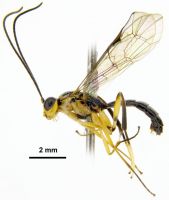ICHNEUMONIDAE: : Euceros Gravenhorst 1829
Diagnosis:
Euceros have a bi-lobed flange mediodorsally on the pronotum, which distinguishes them from other Ichneumonids. However, this can be hard to see - specimens need to be mounted with their head moved downwards to see this.Characteristics of Euceros include: 1. Body size <10mm; 2. Position of spiracle on T1 at, close to, or before centre; 3. No aerolet in forewing; 4. Colour of face is yellow/black; 5. Metasoma compressed dorsal-ventrally; 6. Size of ocelli small; 7. Length of antennae as long, or longer than body; 8. Length of ovipositor barely visible; 9. Wings present; 10. Colour of wings hyaline (clear); 11. Sternaulus absent; 12. Shape of face in lateral view flat or only weakly bulging; 13. Sternite on T1 (viewed laterally) not extending past spiracle; 14. Shape of T1 (viewed laterally) evenly curved; 15. Number of teeth in mandibles 2; 16. Metasoma yellow/black with colourful spots; 17. Length of T1 vs T2 subequal in length; 18. Sculpture on mesoscutum smooth, very polished; 19. Width of T1 (viewed dorsally) gradually widening from anterior to posterior; 20. Glymma on T1 present, (deep pit); 21. Sculpture on metasoma punctured (sometimes less densly or densly punctured); 22. Propodeum reaching past coxal insertion, but not reaching halfway along metacoxae.
Similarity to Other Taxa
Euceros have a bi-lobed flange mediodorsally on the pronotum, which distinguishes them from other Ichneumonids. However, this can be hard to see - specimens need to be mounted with their head moved downwards to see this.Euceros are yellow and black. Usually their metasoma is black with yellow dorsally, making them quite distinct. However, in some specimens the yellow is less obvious, becoming brown.
Distribution in NZ
North Island: AK, CL, HB, TK, TO, WN. South Island: NN, MC, DN.
Species in NZ
One endemic species; Euceros coxalis Barron 1978.Biology & hosts
Eucerotines have stalked eggs which are laid on plants near a “carrier host” (Lepidoptera larvae). The first instar planidium then attaches itself to a carrier host and feeds on its haemolymph, with little effect. If a primary parasitoid emerges from the carrier host, the planidium develops on this. If the carrier host is not parasitised it does not develop. Thus, the true hosts of Eucerotines are not Lepidoptera, but parasitoids, mostly other Ichenumonidae (Valentine & Walker 1991; Gauld 1984).Barron (1978) described several species from Australia, and one from New Zealand. The majority are only known from very few specimens.
The carrier hosts of Euceros coxalis are Ctenopseustis obliquana , Planotortrix excessana , Planotortrix octo , Tortrix notophaea (all Lepidoptera: Tortricidae) (Yu et al. 2005).
Sources of information
Barron JR. 1978. Systematics of the world Eucerotinae (Hymenoptera, Ichneumonidae) Part 2. Non-Nearctic species. Naturaliste Canadien 105: 327-374.Gauld ID. 1984. An Introduction to the Ichneumonidae of Australia. London, British Museum (Natural History). 413 p.
Valentine EW & Walker AK. 1991. Annotated Catalogue of New Zealand Hymenoptera. DSIR Plant Protection Report 4. General Printing Services, 84 p.
Ward DF, Early JW, Schnitzler FR, Hitchmough RA, Stringer IAN. 2012. Conservation status of New Zealand Hymenoptera. New Zealand Entomologist 35 (2):116-119.
Yu DS, van Achterburg K, Horstmann K. 2005. World Ichneumonoidea 2004. Taxonomy, Biology, Morphology and Distribution. CD/DVD. Taxapad. Vancouver, Canada.
Citation
Ward DF & Schnitzler FR. 2013. Ichneumonidae of New Zealand. Genus Euceros http://ichneumonidae.landcareresearch.co.nzAccessed: 23 May 2025



